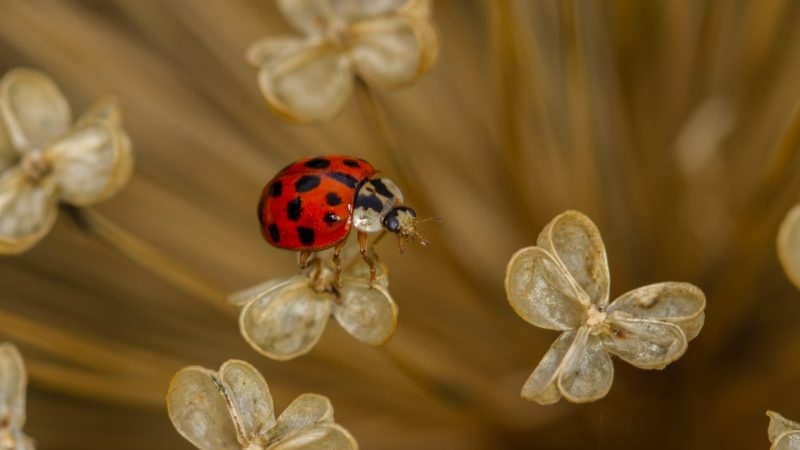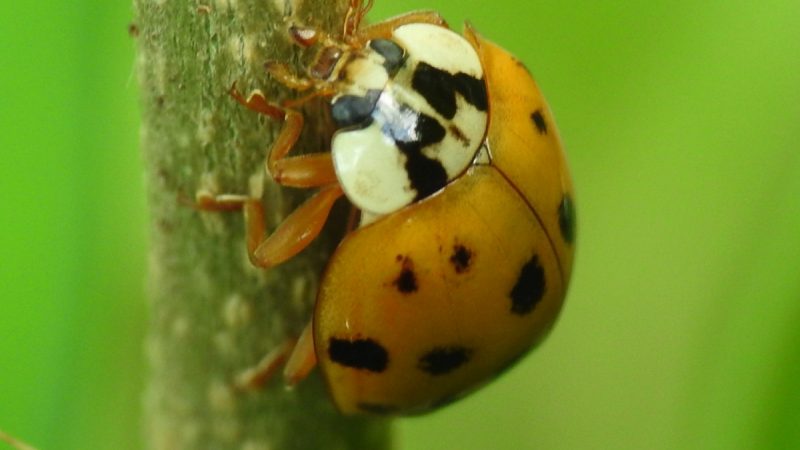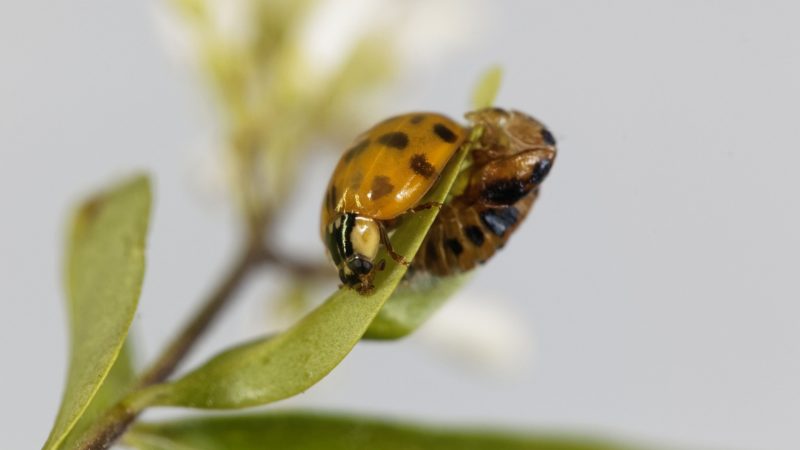Asian lady beetles were first introduced for biocontrol of insect pests. However, due to its habit of overwintering in houses and buildings, often in massive numbers, the Asian lady beetles have turned into pests themselves.
So, how can we get rid of Asian lady beetles? The most frequent method of managing Asian lady beetles is to eliminate any potential entry points by carefully sealing any holes in houses and buildings. When these beetles gain entry, they can be removed and disposed of with a broom and dustpan or a vacuum cleaner.
Asian lady beetles are beneficial insects as they feed on plant pests (aphids) and other soft-bodied invertebrates. In situations where they turn into pests, it is essential to know how to correctly identify, manage, and control the number of Asian lady beetles. Read on to learn more.
Where Do Asian Lady Beetles Come From?
The multicolored Asian lady beetles (Harmonia axyridis) are native to Asia, but they have been introduced in several regions as biocontrol agents of aphids and coccids. To date, they are found to be established in the following countries and areas in Europe and North America, respectively.
| Europe | France, Germany, Belgium, Netherlands, Switzerland, Luxembourg, England and Channel Islands, Italy, Czech Republic, Austria, Denmark, Wales, and Liechtenstein |
| North America | California, Nova Scotia, Connecticut, Delaware, District of Columbia, Georgia, Louisiana, Maine, Maryland, Mississippi, Ohio, Pennsylvania, and Washington |
Asian Lady Beetle Season

Asian lady beetles are cold-blooded species. Thus, these insects tend to gather in large groups for the overwintering period. They are known to hibernate in late fall, winter, and spring. Typically, infestation occurs in September through November.
As the temperatures warm up in late winter and early spring, these beetles disperse slowly from their overwintering sites.
Are Asian Lady Beetles Nocturnal or Diurnal?
Asian lady beetles belong to the family Coccinellidae. As with other members of the Coccinellidae family (ladybugs, lady beetles, and ladybirds), they are mainly diurnal. These insects utilize as much sunlight as possible for feeding and mating. However, flight activities vary depending on weather conditions.
What Do Asian Lady Beetles Look Like?

Multicolored Asian Lady Beetle
Asian lady beetles are most easily distinguished from other species with the W or M-shaped marking on their pronotum or the white area behind their heads. The bodies of adult beetles are oval and convex. They are approximately 1/4 inch (6 mm) long and 1/5 inch (5 mm) wide.
The multicolored Asian lady beetle got its name from its high color and pattern variability. Their colors and spot markings can have more than a hundred variations, taxonomically recognized as forma (forms).
The three main variations of Asian lady beetles are f. succinea, f. spectabilis, and f. conspicua.
- Forma succinea: H. axyridis f. succinea has elytra (front wings) with a ground color of yellow, orange, or red, and 0-21 black spots, which may or may not be well-defined.
- Forma spectabilis: H. axyridis f. spectabilis has black front wings with four yellow, orange, or red spots.
- Forma conspicua: H. axyridis f. conspicua also has black front wings but with only one pair of yellow, orange, or red spots.
These various color morphs of Asian lady beetle are genetically influenced but may also be partly affected by environmental conditions, particularly temperature.
Globally, the presence and frequency of these color morphs vary as some forms may be found predominantly present in one region while others occur in small numbers. For instance, although the three main color patterns have been found to exist in Europe, the f. succinea complex predominates. On the other hand, rare Asian forms such as f. axyridis have not yet been recorded.
Asian Lady Beetle in Gardens
Asian lady beetles are beneficial insects that are usually found in gardens. These beetles feed on aphids and other soft-bodied insects that are known to cause damage to agricultural fruits and crops (plum, peach, apple, and cabbage), ornaments (rose, tulip, crepe myrtle, magnolia), and other plants.
Asian Lady Beetle vs. Ladybug
The terms ladybug, ladybird, and lady beetles all refer to the members of the family of beetles (Coccinellidae). Nearly 6,000 species of ladybirds have been identified globally. One of which is the Asian lady beetle or also known as the Asian ladybug.
Ladybird is a term more commonly used in England, whereas ladybug is the more popular term in the US. Although the name “ladybug” incorporates the word “bug,” it refers to beetles (order Coleoptera) rather than bugs (order Hemiptera). Scientists, on the other hand, prefer using the term lady beetles.
Various species of Coccinellidae share many characteristics. Adult beetles are dome or oval-shaped, with body lengths ranging from 3/64 inch (1 mm) to 25/64 inch (10 mm). Asian lady beetles are approximately 1/4 inch or 6 mm in length.
In addition, adult beetles can vary in coloration within and among species. Most color variations tend to range from yellow to red with black or just purely black.
Multicolored Asian lady beetle can exist in hundreds of color morphs but can easily be distinguished from other species by examining the W- or M-shaped mark in the white area behind their head.
Related: Ladybug Control: How to Get Rid of Ladybugs?
Asian Lady Beetle Larvae vs. Ladybug Larvae
As with other members of the Coccinellidae family, the larvae of Asian lady beetles are soft-bodied, often black in color with bright orange markings, and typically covered in small spikes.
Despite having an alligator-like appearance, the larvae of Asian lady beetle are quite harmless to humans.
Life Cycle of Asian Lady Beetle

Asian lady beetles follow a four-stage life cycle: egg, larvae, pupa, and adult. Depending on the weather (temperature) and food supply, it would take at least 36 days for an egg to develop into an adult, with up to six generations in one year.
Egg
Adult Asian lady beetles begin laying eggs in early spring. Their eggs are small, oval-shaped (about 1/16 inch long) with a yellow to bright yellow-orange color. Typically found on the underside of leaves, these eggs are laid upright in clusters ranging from 5-30.
Eggs usually take 3-5 days to hatch.
Larvae
The larvae of Asian lady beetles resemble tiny alligators, which could grow up to 1/3 inch (8 mm) long. They usually have dark-colored bodies with bright yellow or orange markings on their abdominal segments and are covered with fleshy spines.
The larvae would feed on aphids, scale insects, and other soft-bodied invertebrates for about 12 to 14 days.
Pupa
The larvae of Asian lady beetles molt four times before entering the non-mobile pupal stage. With each molting, the larvae grow in size until it’s about the same size as the adult Asian lady beetle.
The pupa of Asian lady beetles has distinct segments and two parallel, longitudinal rows of black spots. They can usually be found attached to the leaves of plants where their food is abundant.
Once the larvae molt into a pupa, it takes about five to six days for an adult Asian lady beetle to emerge from the pupal case.
Adult
An adult multicolored Asian lady beetle is approximately 1/4 inch (6 mm) long and 1/5 inch (5 mm) wide. Although they appear in various colors and patterns, they can be easily distinguished from the native beetles through the W or M-shaped marking on their pronotum.
Adult Asian lady beetles are oval-shaped with black spots that vary in size and numbers.
Are Asian Lady Beetles Harmful to Humans and Pets?

Asian lady beetles have been known to bite humans, which can cause allergic reactions. Some people were also reported to have developed several allergic responses such as rhinoconjunctivitis, asthma, urticaria (welts), and angioedema caused by the defense chemicals in the blood of Asian lady beetles.
Other than allergies and skin irritation, Asian lady beetles pose no serious risk to humans and animals. They are also neither poisonous nor harmful to humans if eaten.
In general, Asian lady beetles are not harmful to pets. However, if cats would try to eat them, the defense chemicals secreted by these insects could cause minor irritation to the cat’s mouth. On the other hand, if dogs try to eat them, the defense chemicals of these insects could cause minor irritation to the dog’s mouth.
How to Control Asian Lady Beetles?
Although Asian lady beetles are considered beneficial insects, they also tend to become a nuisance to homeowners, especially since they often invade houses in large numbers. As cold-blooded species, these insects gather in large groups and hibernate during the winter.
To control them, you can do the following:
- Asian lady beetles can fit through openings as small as 1/8 inch (3.18mm). The most effective way of protecting your homes from these insects is by sealing cracks and any openings using silicone , elastomeric latex , or silicone/acrylic caulks .
- Windows, doors, and exhaust vents can also be covered with a fine mesh (maximum of 20 mesh) to keep these beetles out.
- Since Asian lady beetles are attracted to light-colored surfaces, it would be best to choose dark-colored paints when exterior repainting is needed.
How to Get Rid of Asian Lady Beetles?
Insecticide
The use of insecticides is one of the preventive measures to repel Asian lady beetles. Chemical treatments with synthetic pyrethroid may be applied on possible entry points such as windows and doors. These insecticides have long-lasting residual activity, which could last for about three weeks.
The interior application should be avoided as the accumulation of dead beetles may attract other insects that feed on decomposing Asian lady beetles. For the same reason, pesticide application should be avoided during spring when they are about to leave their overwintering sites.
Bug Traps
Asian lady beetles are known to be attracted to light and light-colored surfaces; thus, making light traps effective in capturing these insects. These traps could be placed strategically in areas that are relatively dark and confined, and where there are no competing light sources.
Commercial black (ultra-violet) light traps are most commonly used in catching crawling and flying lady beetles. In addition, sticky tapes or boards may also be placed in areas where these beetles could enter to reduce their numbers.
- POWERFUL INDOOR PEST CONTROL LAMP | Versatile Home Bug Catching...
- CONVENIENT DESIGN MOUNTS TO WALL | With its Chic White...
- BRIGHT UV LIGHT & SIMPLE STICKY STRIPS | Plug In Ultraviolet Lamp...
- EASY TO CLEAN & SUPER AFFORDABLE | For Reliable Year-Round Bug...
- SAY GOODBYE TO BITING MOSQUITOES & MORE | Our All-Purpose Indoor...
How to Get Rid of Asian Lady Beetles Naturally?
When found indoors, spraying with insecticide is unnecessary and highly discouraged as these are toxic to people. Moreover, killing Asian lady beetles is also not recommended because they are considered beneficial insects.
Thus, the following are some natural ways to get rid of them:
Broom and Dustpan, or a Vacuum Cleaner
When seen indoors, Asian lady beetles can be removed using a broom and a dustpan or a vacuum cleaner.
Using a broom and a dustpan is highly recommended since it does not harm these insects. These beetles can be swept up and placed in a container, after which they can be released outdoors.
On the other hand, using a vacuum crevice tool might kill these insects, which would leave an unpleasant odor if left in the vacuum cleaner bag for a couple of days. Thus, it is essential to regularly change and immediately dispose of used vacuum bags after vacuuming, as surviving beetles might escape from the cleaner into your house.
To prevent these beetles from entering and potentially damaging the vacuum, a knee-high nylon stocking, secured with a rubber band, may be placed into the end of the extension hose or wand to bag the insects.
Vacuuming should also be done carefully as lady beetles tend to secrete yellow defense chemicals when disturbed, which could stain walls and other surfaces.
Essential Oils
One way to keep these Asian lady beetles out of your house is by hanging cotton balls containing a few drops of camphor essential oil in the corners of windows. The use of was also found to be effective insect repellents. Furthermore, you may prepare a home spray with these essential oils.
- Premium Quality Camphor Essential Oil: SVA Camphor Essential Oil...
- Hair Care: SVA Camphor Oil is suitable for massage on hair and...
- Body Massage: SVA Camphor Oil is useful for application on the...
- Diffuser & Aromatherapy: SVA Camphor Oil has a strong and minty...
- Multiple Uses: You can use SVA Camphor oil for several DIY...
Although it has not been tested in the field, laboratory experiments showed behavioral changes in Asian lady beetles when exposed to derivatives of terpenoids isolated from catnip oil.
Predators
There are only a few known natural enemies to thin out the numbers of Asian lady beetles. Some of their predators are few birds, true bugs, and some other ladybirds.
Asian lady beetles were also found to be susceptible to fungal pathogens. Although the impact is still unclear, heavy infections would impede flight, foraging, and mating; thus, suppressing the population of these beetles to a certain extent.
Summary
Multicolored Asian lady beetles are beneficial insects that feed on aphids and other soft-bodied insects. Although they are considered biocontrol agents, they are also regarded as pests.
Infestation can be prevented by caulking cracks and any openings that may provide entry to these beetles. You can also use insecticides containing synthetic pyrethroid and essential oils such as camphor, menthol, and catnip.
If these beetles gain entry, they can be removed by using a broom, a brush, or a vacuum. Light traps may also be utilized. Spraying insecticides or using traps that kill these lady beetles are highly discouraged since Asian lady beetles are regarded as beneficial species.
List of Sources
Potter, M. F., Bessin, R., Townsend, L. (2005). Asian Lady Beetle Infestation of Structures. University of Kentucky.
Kondo, T., Fuentes, G. G. (2013). The multicolored Asian lady beetle, Harmonia axyridis (Pallas, 1773) (Coleoptera: Coccinellidae), a not so new invasive insect in Colombia and South America. Insecta Mundi: A Journal of World Insect Systematics.
Erler, E. (2019). How can I get rid of Asian ladybugs in my house? University of New Hampshire.
Bessin, R. (2019). Ladybugs. University of Kentucky.
Multicolored Asian Lady Beetle. University of California Agriculture & Natural Resources.
- How to Get Rid of Turtles | Proven Long-Term Solutions! - August 26, 2023
- How to Get Rid of Kingsnakes | Easy & Humane! - August 26, 2023
- How to Get Rid of Northern Water Snakes | Best Solutions and Preventative Measures! - August 19, 2023


